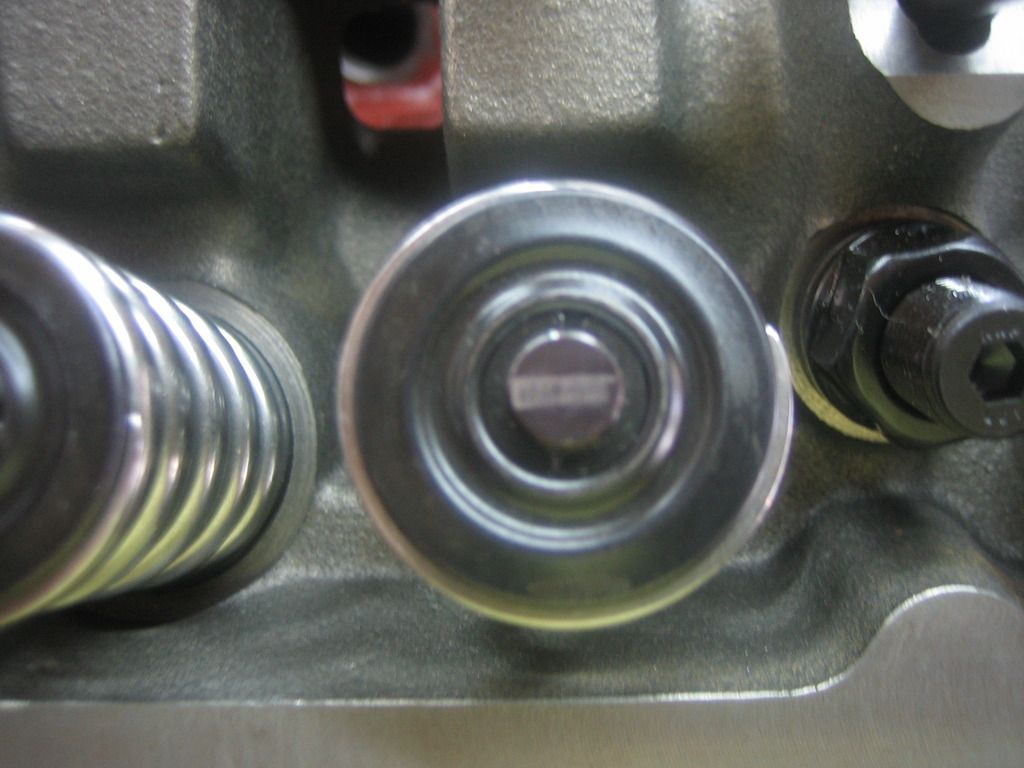Dragonbat13
Well-Known Member
What brand of keepers?
Are those keepers the type that allow for added installed height?
Are those keepers the type that allow for added installed height?
I'm sorry to see the carnage and all that money and effort lost. I can guarantee that you had valvetrain issues that caused the failure. The locks are simply located by the tang. It is not for holding the assembly together. The colleting effect of the lock angle does that, which btw, is better with a seven degree than it is with a ten degree. The tangs shearing off is from severe valve float.
When you check the sweep, I bet you will find over .100" lateral movement across the tip of the valve. That is only about 300% more than what it should be. Pretty typical of just bolting on a set of roller rockers without correcting the geometry.
If you don't want to take my word for it, call PRW and talk to Shawn. Tell him you had valvetrain issues with a Mopar roller rocker, and see what he tells you.
I feel bad for you, but unfortunately I see it all the time. There is more bad Mopar valvetrain information out there than you can shake the proverbial stick at, and it results in this kind of damage. It frustrates me to no end.
Do the valve float and lateral movement have anything to do with each other? Not challenging; I just can't see the lateral movement causing valve float. We still don't know lift, spring rates/pressures, and the other parts of the system or max RPM's seen; that would be helpful in judging valve float.The tangs shearing off is from severe valve float.
When you check the sweep, I bet you will find over .100" lateral movement across the tip of the valve. That is only about 300% more than what it should be. Pretty typical of just bolting on a set of roller rockers without correcting the geometry.
Yes, it absolutely does! There are accelerations and decelerations incurred when rotational motion is converted to linear motion (think crankshaft to rod/piston). When using a roller rocker, the fulcrum (pivot) point of the rocker is too low, and causes the valve to come off the seat slowly, and accelerate when it gets to higher lifts (wide sweep). Then, when the lifter comes over the nose of the cam, everything starts to back up, but the valve is now at, or near, its highest velocity going the opposite direction. Since it had no time to decelerate, the spring loses control and the valve floats. When the spring does finally bring the valve back, it slams into the rocker and sends a shock wave through the whole valvetrain. It doesn't take long for things to start breaking. Oh, for what it's worth, perfectly centering the sweep on the tip of the valve does nothing but make you feel good if the fulcrum point is not corrected. You can have the sweep perfectly centered, and still have the effective geometry off by well over .250". I've seen as much as .345" and I'm sure there has been worse.Do the valve float and lateral movement have anything to do with each other? Not challenging; I just can't see the lateral movement causing valve float. We still don't know lift, spring rates/pressures, and the other parts of the system or max RPM's seen; that would be helpful in judging valve float.
You can find them on the website in my signature. There's nothing like free info, especially when it's correct info.
I guess someone didn't like my signature and edited it.:sad5:
I guess someone didn't like my signature and edited it.
Thanks for the plug on the tech articles, but nobody knows where to go. I can't post the link, but you can.OThe sites hard on non sponsor business's posting links but your input in greatly appreciated . I have the info you sent me in July but the car just got home from Moparfest on the train last week so I'll be getting you the data for my kit soon . I would strongly advise anybody that does any of their own wrenching read his tech articles , don't look at it as added power but added peace of mind .
PS Can't wait for the next series of info ......
Nah, I didn't think it was you. I just thought you were wondering what happened to the web address. Shows how much I know the smilies. LolI didnt edit the sig (I didnt even know that was a rule), I was just waiting on the flaming.
However I did read some of your article, and plan on reading the whole thing multiple times. It does seem to be some good stuff to know, thats for sure.
Sorry for the offensive nature, wasnt intended to get your sig KO'ed.

one keeper lower than the other looks like and results in bad news-made in china junk. did u rev it to the moon and float valves? was there enough valve spring load for you?
Easy now, I didn't say they were stronger, I said they had more colleting effect on the valve stem. They won't unlock as quickly as a 10 degree lock will. They can pull through the retainer with high spring loads and valve float, but strength wise, the 10 degree has a heavier wall, which makes it stronger, all else being the same.I didn't see anything that look destroyed. A sleeve is cheaper than doing another block. And those heads can be repaired inexpensively.
Looks like valve float to me as well.
Also, Mike is correct 7* locks are stronger than 10*. but in this case either one should not have failed.
